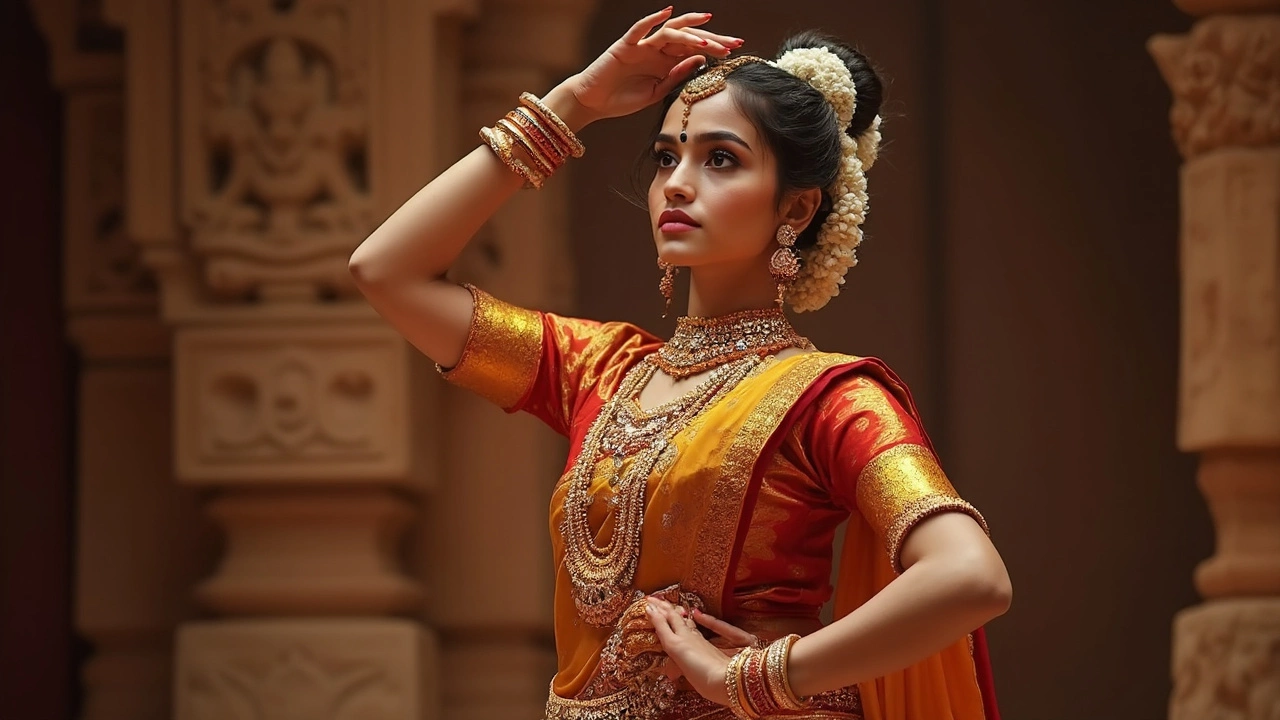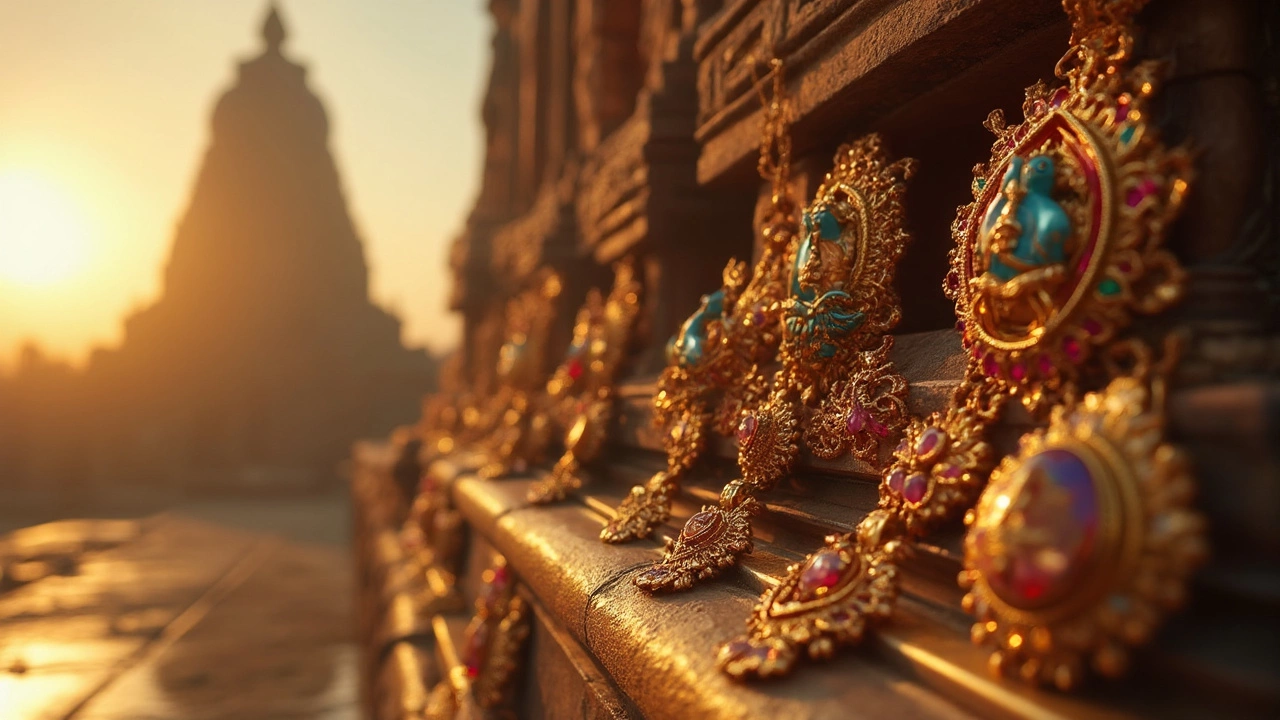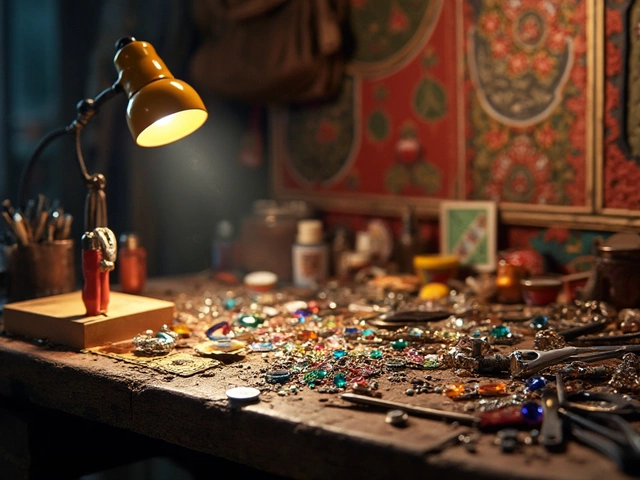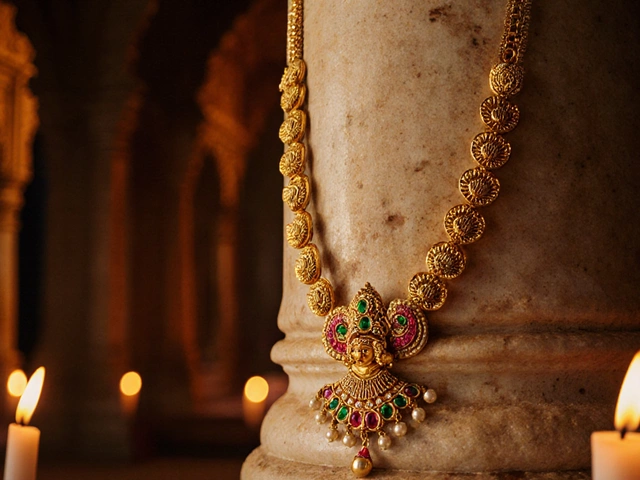Traditional Indian jewelry, especially temple jewelry, holds a special place in the heart of India's historical and cultural tapestry. But what exactly is it called? Well, it's pretty straightforward—it's often referred to simply as 'temple jewelry.' This isn't just any jewelry; it connects deeply with spirituality and artistry, featuring designs you’d typically spot on Indian deities and classical dancers.
Imagine stepping into a temple in southern India, say Tamil Nadu or Kerala, and you'll likely be mesmerized by the glinting jewelry adorning the idols. Now, here's a fun fact: this type of jewelry isn't just for show. In fact, temple jewelry got its start by adorning statues of gods and goddesses in temples. Over time, it became a favorite choice for dance performances and bridal adornments. It’s not just jewelry; it’s heritage worn proudly.
- The Historical Roots of Temple Jewelry
- Symbolism and Spiritual Significance
- Crafting the Masters: Artisans Behind Temple Jewelry
- Modern Trends in Temple Jewelry
- Tips for Buying Authentic Temple Jewelry
The Historical Roots of Temple Jewelry
Let's rewind a bit to understand how traditional Indian jewelry like temple jewelry came about. We're talking centuries back when South India was a vibrant hub of art, culture, and religious practices. Temple jewelry, named for its initial use in temples, started as grand offerings to the deities. Intricately crafted in gold, these pieces were more than just ornaments; they were sacred gifts symbolizing devotion and prosperity.
During the Chola and Pandya dynasties, which ruled around the 9th to 13th centuries, temple jewelry craftsmanship hit its peak. Kings and queens commissioned stunning jewelry pieces to honor temple idols. Artisans, revered for their craft, were tasked with creating these masterpieces. The designs were inspired by nature and the divine, often featuring lotus motifs, peacock shapes, and other religious symbols.
Evolution Beyond Temples
Around this time, the jewelry also caught the attention of classical dancers and royalty. Bharatanatyam dancers began wearing these pieces during performances, as they were believed to please the gods and enhance the dancer's divine appearance. Over time, temple jewelry became synonymous with dance and celebration, gradually finding its way into traditional bridal wear, especially in South India.
Fast forward a few centuries, and the legacy of temple jewelry endures. Artisans continue to pass down the skills, ensuring that these stunning pieces remain a living tradition. This jewelry isn't just a nod to the past but an integral part of cultural festivities today. Whenever you see Bharatanatyam dancers or a South Indian bride, it's like a glimpse into a rich history where art, devotion, and tradition collide beautifully.
Symbolism and Spiritual Significance
Let's dive into the fascinating world of symbolism behind traditional Indian jewelry, especially the revered temple jewelry. These pieces aren't just about aesthetics; they carry deep spiritual meaning that dates back centuries, connecting wearers to their roots and the divine.
Divine Connections
Temple jewelry originally adorned deities, a practice that infused these ornaments with a sacred aura. Wearing these replicas allows individuals to carry a piece of that divinity with them. Designs often include gods and goddesses, each symbolizing different virtues and stories from Hindu mythology. Imagine feeling that kind of spiritual connection every time you put on a necklace or earrings!
Symbols and Meaning
The motifs used in temple jewelry aren't random. For example, the lotus symbolizes purity and creation, while the peacock represents grace and beauty. Religious symbols like Om and sacred cows are also popular, serving as daily reminders of one’s faith and heritage. Wearing these pieces isn't just about looking good; it's about embodying these qualities as you go about your day.
Astrological Beliefs
You may not know this, but many believe that traditional jewelry can have astrological benefits. Certain metals and stones are thought to bring harmony to one's life, aligning with the stars to create balance and well-being. It’s like wearing your good luck on your sleeve—quite literally!
Whether you're drawn to the religious motifs or the believed benefits, temple jewelry offers a deep, meaningful journey into India's cultural and spiritual landscape, making each piece so much more than a mere accessory. And let's face it, who wouldn't want a little extra luck and divine connection in their life?

Crafting the Masters: Artisans Behind Temple Jewelry
Ever wondered who are the masterminds behind the beautiful traditional jewelry we admire? It's all thanks to the incredible artisans who painstakingly craft each piece by hand. Let's dive into their world.
The Legacy of Craftsmanship
The skills required to craft temple jewelry aren't learned overnight. Many artisans are part of families that have been in this line of work for generations, passing down techniques and secrets like family heirlooms. It's a legacy of precision, patience, and passion.
Materials and Techniques
To create these masterpieces, artisans often rely on high-quality metals like gold and silver. They employ a method called 'lost-wax casting,' a technique dating back 4,000 years! It involves creating a wax model of the jewelry, encasing it in clay, and then heating it to pour molten metal into the cavity left behind.
After casting, gemstones like rubies, emeralds, and pearls are carefully set into the designs. Artisans also utilize detailed engravings and filigree work to enhance the jewelry's visual appeal, a nod to both tradition and artistry.
Challenges Faced by Artisans Today
Despite their incredible talent, the artisans face modern challenges. With rising costs of raw materials and the push for faster production, maintaining the authenticity of these pieces can be difficult. Preserving these age-old techniques is as essential as ever.
Statistics and Facts
The craft industry, including Indian jewelry, contributes significantly to the local economies in regions like Tamil Nadu. A 2023 survey indicated that around 25,000 artisans are currently involved in this sector across the southern states of India.
So next time you see a piece of temple jewelry, take a moment to appreciate the history, skill, and craftsmanship poured into it. It's not just an accessory; it's a piece of living heritage.
Modern Trends in Temple Jewelry
Temple jewelry, with its deep roots in tradition, isn't stuck in the past. In fact, it's experiencing a resurgence, and some contemporary spins make it totally versatile for today's style hounds.
First up, mixing metals is all the rage. While traditional pieces were often gold-centric, modern designs mingle silver, platinum, and even rose gold. Why stick to one when you can have them all, right?
Fusion Designs
The introduction of fusion styles has brought a fresh perspective. Imagine wearing a traditional jewelry pendant with a western outfit. Sounds cool? Fusion designs blend temple motifs with modern aesthetics, creating pieces that feel equally at home in an office or at a cultural event.
Incorporating Gemstones
Gemstones have also made a lively appearance. While rubies and emeralds traditionally featured in temple jewelry, today, jewelers are adding a splash of color with sapphires, amethysts, and even semi-precious stones. The result? Jewelry that's both traditional and trendy.
Sustainable Practices
There's been a big push towards sustainability as well. Artisans are adopting eco-friendly techniques, focusing on recycled metals and ethical gemstone sourcing. More buyers now prefer knowing their Indian jewelry isn't just beautiful but also crafted with care for the planet.
The Demand for Customization
Customization has also taken the scene by storm. Whether it's personalizing a piece with initials or creating something entirely bespoke, customization ensures that you own a piece of tradition that's uniquely yours.
So, whether you're a bride looking to dazzle on your big day or just someone who loves adding a touch of Indian fashion to their daily attire, modern temple jewelry has something dazzling for everyone.

Tips for Buying Authentic Temple Jewelry
Shopping for authentic traditional jewelry can be a bit of a treasure hunt, but trust me, it’s worth it. You want to make sure you’re getting the real deal, something that's genuine and not just a flashy imitation.
Know Your Materials
Most real temple jewelry is crafted with silver, often plated with gold for that luxurious finish. Look for hallmarks or certifications that indicate genuine silver or gold. If you have a chance, a quick test with a magnet can help; precious metals won’t be magnetic.
Check for Intricacy
The appeal of Indian jewelry, particularly temple types, lies in the intricate designs. Handcrafted pieces will have a certain charm and tiny imperfections that machine-made ones lack. Look closely at the detailing; it should tell a story or portray traditional motifs.
Reputation of Jewelers
Stick to known brands or jewelers with a rich history in the art of temple jewelry. Ask for credentials or read reviews. Reputable sellers will be transparent about the materials, origins, and crafting processes.
Ask for Certifications
Always ask for authenticity certificates or any documentation that can validate the age and quality of the jewelry. This is especially important if you’re investing a significant amount of money.
Price Points
Remember, you get what you pay for. If a deal seems too good to be true, it probably is. Compare prices from a few sources, and if something stands out as suspiciously cheap, proceed with caution.
Meet the Artisans
When possible, see if you can visit workshops or stores where the jewelry is crafted. Seeing the artistry in action not only enhances appreciation but also reassures you of its authenticity.
Here’s a quick look at the authenticity checks:
| Check | Importance Level |
|---|---|
| Material Verification | High |
| Craft Detailing | Medium |
| Certificates | High |
| Price Comparison | Medium |
By following these tips, you can ensure your Indian jewelry is both authentic and beautiful, a true reflection of India's rich heritage.



